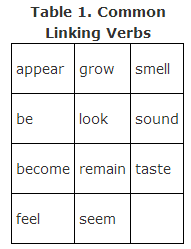Action Verbs and Linking Verbs
An action verb animates a sentence, either physically ( swim, jump, drop, whistle) or mentally ( think, dream, believe, suppose, love). Verbs make sentences move; sometimes dramatically, sometimes quietly.
She leaped high into the air, twirled, landed on the floor, and ran from the room.
He thought of her beauty, imagined her smile, yearned for her presence.
Some verbs don't express action but help complete statements about the subject by describing or identifying it. These verbs are called linking verbs.
Diane is happy.
Clement feels feverish.
Maria is a doctor.
The music sounds good.
The sentences don't tell you what Diane, Clement, Maria, and the music did but rather what they are. Linking verbs “link” their subjects to a classification, state of being, or quality. In the sentences above, happy, feverish, doctor, and good are called complements of the linking verbs. Table 1 lists some common linking verbs.

Some of these verbs can be both linking and action verbs.
Clement felt hot. (linking verb)
Clement felt along the wall for the light switch. (action verb)
The dog smelled bad. (linking verb)
The dog smelled the man's boots. (action verb)
A quick way to tell whether a verb is functioning as a linking verb is to see if you can replace it with a form of the verb to be and still have a logical sentence. For example, test the two sentences above by replacing smelled with was.
The dog was bad. (yes)
The dog was the man's boots. (no)
Linking verbs operate differently than action verbs. First, while action verbs are modified by adverbs, linking verbs are often followed by adjectives.
This cheese smells strong.
NOT This cheese smells strongly.
Also, a pronoun following the linking verb to be should be in the subjective case rather than the objective case.
It was she.
NOT It was her.